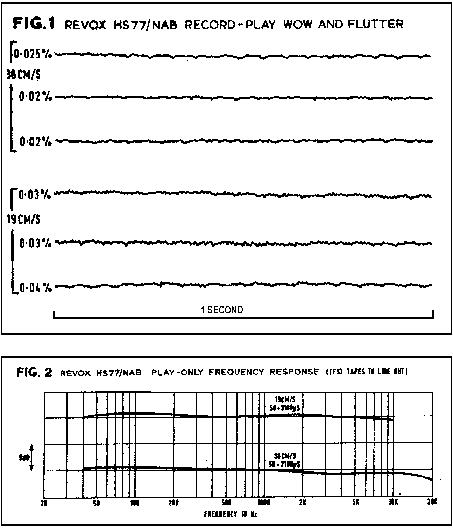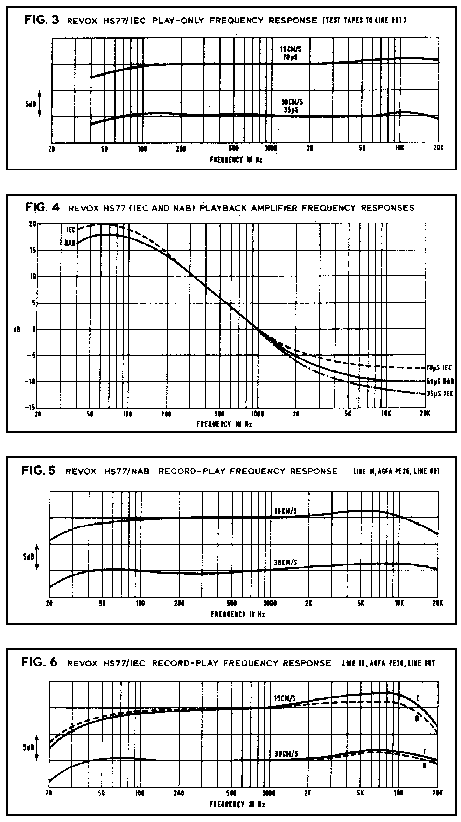equipment reviews
REVOX HS77 NAB
AND IEC PROFESSIONALMANUFACTURER'S SPECIFICATION
(Agfa PE36 at 38 cm/s). Professional mains transportable stereo recorders with Tachometer capstan motor .speed control. Tape Transport: Direct capstan drive, separate motors for fast forward and reverse wind. Wow and flutter: 0.04% maximum. Tape slip: less than 0.2%. Spool capacity: 26.5 cm, NAB hubs. Frequency response: 30 Hz - 20 kHz ▒ 1.5dB. Distortion: 2%. Equalization: NAB or IEC to order. Signal-to-noise ratio: 60 dB. Crosstalk: (1 kHz): 45 dB stereo, 60 dB mono. Tape speed, 38 and 19 cm/s. Bias frequency: 120 kHz. Inputs: 0.15 mV at 50 ohms to 6 K or 2 mV at 100 K (microphone, switchable); 2 mV at 33 K (radio); 40 mV at 1 M (auxiliary). Outputs: 2.5 V at 600 ohms (line); 1.2 V at 2.5 K (radio). Weight: 15 kg. Dimensions: 359 x 215 x 413 mm (plus spool overhang). Prices: On application. Manufacturer: Willi Studer, CH-8105 Regensdorf, Zurich, Switzerland.
Fig. 1
shows the pen recordings of cumulative wow and flutter at 38 and on the UK modified (HS77/NAB) recorder. At 19 cm/s the WHM fluttermeter reading remained steady at 0.03 % RMS for long periods. Only occasionally did it rise to 0.04%. as record and play speed fluctuations come into step for short periods. At 38 cm/s, the meter reading remained rock steady at 0.02% RMS with very occasional excursions to an absolute maximum of 0.025 %.
Bulk erased tape was 61.5 dB below reference and machine-erased tape was exactly 60 dB below 32 mM/mm 1 kHz reference tape level.
All the above distortion and noise levels were identical at 19 and 38 cm/s.
The Swiss HS77/IEC recorder was tested with the identical Agfa PE36 LP tape to give the overall frequency responses of fig. 6. It was obvious that the top track bias was a bit low at 19 cm/s, resulting in the rising high note response and very slightly lower mid and low frequency responses shown by the solid curve. The bottom track was nearer the optimum bias and pre-emphasis settings for the recommended Agfa tape as shown by the dotted response at 19 cm/s.
At 38cm/s top and bottom tracks were almost identical and the response was within the specified limits from 30 to 20 kHz.
Unweighted system noise was -58 d below reference tape, level and weighting it to the IEC 'A' response gave the very low reading of -66 dB. This reading remained the same at 19 and 38 cm/s.
Bulk-erased tape noise was -62.5 dB at 19 and -64 dB at 38 cm/s. Machine-erased noise was -60.5 dB at 19 cm/s and -62 dB at 38 cm/s. These noise differences with tape speed are mainly due to the change of extreme HF response as the playback equalization is switched from 70 to 35 ÁS as shown in
(Remark: Historical information, original published approx. in 1970. Please note that the adresses and phone numbers may not be correct any longer.)